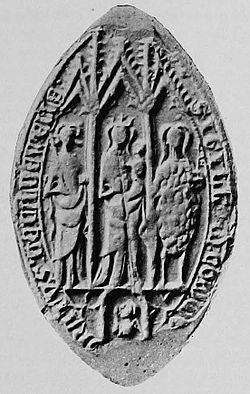Caldwell Priory

Seal of the Priory of Caldwell
|
|
| Monastery information | |
|---|---|
| Order | Canons of the Holy Sepulchre, Augustinians |
| Established | 1154 |
| Disestablished | 1536 |
| Site | |
| Location | Bedford, Bedfordshire, England |
Caldwell Priory was a priory of Canons of the Holy Sepulchre in Bedfordshire, England, from circa 1154 to 1536. It was situated in the south-west of Bedford on the south bank of the River Great Ouse.
The origin of the priory of Caldwell is somewhat obscure. Its earliest charters of endowment are of the reign of Henry II, but undated; but as a prior of Caldwell witnessed a charter granted by Robert de Brus, 2nd Lord of Annandale to Harrold during the lifetime of Malcolm IV of Scotland (1153–65), it may be concluded that this house, like so many others in Bedfordshire, was founded early in the reign of Henry II or perhaps in that of Stephen. The founder's name is unknown. The Close Roll of 13 Edward III speaks only of 'the ancestors of Simon Barescote of Bedford'; Leland, by naming Simon Barescote in one place, and in another assigning the foundation to the Beauchamps or the Beaumonts, shows that there were several contradictory traditions in existence in his time. The priory belonged at first to the Canons of the Holy Sepulchre and was dedicated to St. John Baptist; but after the thirteenth century it probably ceased to be in any way distinguished from the other Augustinian houses. The Canons of the Holy Sepulchre were only separated from other Augustinians by their name, and the scarlet badge on their cloaks; in all probability they kept exactly the same rule, as on two occasions canons of Dunstable Priory were invited to be priors of Caldwell, while it was still called by the name of the Holy Cross.
Four churches in Bedfordshire – Bromham, Roxton, Sandy and Oakley with the chapel of Clapham – belonged to Caldwell at the beginning of the thirteenth century; Marsworth and Broughton in Buckinghamshire, and Arnesby in Leicestershire before 1291; Tolleshunt Major in Essex at a later date. Its temporal possessions lay for the most part within the county of Bedford, and were never very extensive; in 1291 they were worth less than £50.
...
Wikipedia
